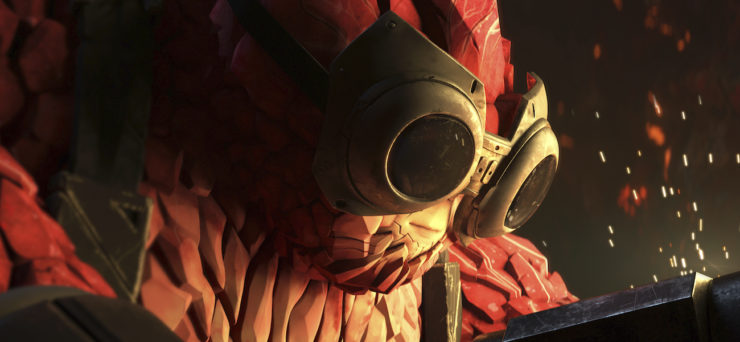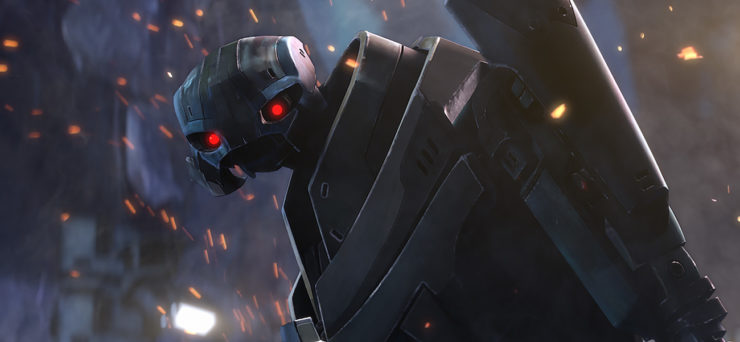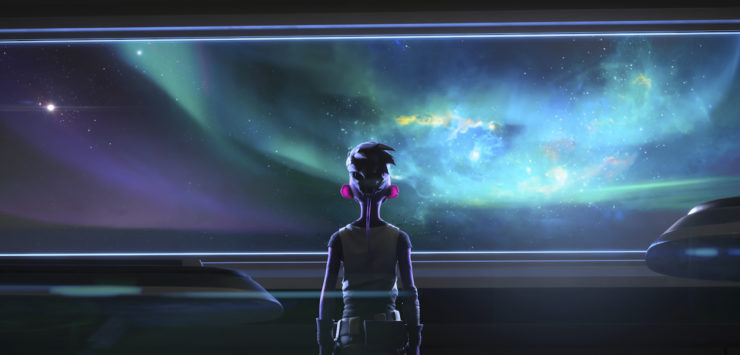In the 1970s, Filmation produced an animated Star Trek series that was very much intended not to be a dumbed-down version of the live-action series. The general approach was to treat this like the fourth season of the TV show, and while some concessions were made to the Saturday morning timeslot (not to mention the more limited time frame of a half-hour episode as opposed to an hour), the show generally kept to the spirit of the live-action show that came before it.
The second of Secret Hideout’s animated series, and their fifth overall, Star Trek: Prodigy is specifically designed for children. It’s also the best Trek show of the current slate of Trek productions, and that’s not meant to disrespect Discovery, Short Treks, Picard, or Lower Decks—it’s just that Prodigy is that good.
SPOILERS FOR THE FIRST TWO EPISODES AHEAD!
The intent of Prodigy is to help introduce a new generation of fans to Star Trek. Indeed, the original plan was to release Prodigy on Nickelodeon, only going to what was then called CBS All Access later on. The Apocalypse Of 2020 changed all that, as the rechristened Paramount+ was in need of content after not being able to produce new material throughout much of 2020, so now Prodigy is debuting on the streaming service. However, it will also air on Nickelodeon, a cable channel where it can most easily reach its target audience, soon enough. Rather than the crude animation provided by Filmation in the 1970s or the stylized animation we’re getting on Lower Decks, Kevin and Dan Hageman (Trollhunters) are providing some beautiful and complex computer-animated visuals for Prodigy.
I mentioned that the target audience is on Nickelodeon, but honestly this show’s audience is anyone who loves Star Trek, because this is very much a Trek show.
The setup is not going to blow anyone away with its originality, but I don’t really think that matters over much. Still, Prodigy shares DNA with plenty of other TV shows and movies, where a small group of people find themselves thrown together not-entirely-expectedly on a space ship to have adventures. It’s another variation on a theme we’ve seen in Gene Roddenberry’s Andromeda, Guardians of the Galaxy, Farscape, Cowboy Bebop, Firefly, Blakes 7, Space Cases, and lots of others.
You’ll note, however, that that list doesn’t include any other Trek productions. While the action of Prodigy takes place on a Starfleet vessel, the U.S.S. Protostar—which has an “NX” designation, indicating that it’s an experimental vessel—that’s the only Starfleet presence in this show (which extends to the ship’s command training hologram, which is modeled after Captain Kathryn Janeway of the U.S.S. Voyager, the medium of animation allowing Kate Mulgrew to return to a version of her iconic role from two and a half decades ago). The main characters are a bunch of imprisoned slaves who manage to escape from a planet that seems to be in the Delta Quadrant, where they’ve been forced to mine chimerium.
The chimerium mining is a front, however. The person who runs the mine, an alien simply known as “the Diviner” (voiced magnificently by the great John Noble) is truly seeking the Protostar. Unfortunately for him, two of the miners find it first…

Our main character is Dal, voiced by Brett Gray, and he’s the devil-may-care, seat-of-the-pants wisecracking rogue character common in the genre—see also Star Lord, John Crichton, Mal Reynolds, Han Solo, etc.—and he’s also, it must be said, the least interesting character in the bunch. This is not to say he’s completely uninteresting—for starters, he himself doesn’t even know what his species is, and Gray does a particularly fine job of showing how much Dal’s freewheeling attitude is hiding a tremendous amount of pain.
The rest of the crew is much more interesting. I particularly love that one of the crew is a Medusan. This species, introduced in the original series’ “Is There In Truth No Beauty?” are great navigators, telepaths, and also have true forms that can’t be seen by most people lest they go mad. The Medusan goes by “Zero,” as the Diviner refers to them as “Fugitive Zero” when they escape. Angus Imrie voices Zero with a magnificently overblown curiosity and a certain befuddled charm.
We’ve also got a Tellarite named Jankom Pog, and we know that’s his name because he refers to himself in the third person. Jankom, voiced by Jason Mantzoukas is an engineer who right at the outset declares his love of percussive maintenance. I’m very much looking forward to seeing how his blunt, improvisational style of engineering mixes with a Starfleet ship. Especially since the Protostar has two warp cores (twice as many as any other ship we’ve seen) and something else that looks very suspiciously like a slipstream drive.
Gwyn, voiced by Ella Purnell, has the Aeryn Sun/Nebula role of person who’s on the bad guys’ side, who presumably will eventually see her way to helping the good guys. Gwyn is the daughter of the Diviner, and she’s convinced that Dad will come to rescue her (though that appears to be incidental to his wanting to get his hands on Protostar). There’s also Murf, the most obvious sop to this being a kids’ show. Murf is a big blob of goo who doesn’t appear to be sentient, and who likes to eat the furniture. Voiced by the great Dee Bradley Baker, Murf will either be the most popular or the most hated character on the show. Me, I don’t hate him, and I love the idea of an alien who’s, basically, a gelatinous cube.
My favorite character, though, by far is Rok-Tahk, voiced by Rylee Alazraqui. The unsubtly named Rok is a Brikar, and she pretty much looks like the Thing from the Fantastic Four. She’s also the basis of the funniest moment in the two-part premiere episode, “Lost and Found.” The Diviner has forbidden translators in his mine, so the prisoners can’t talk to each other. When he’s sent to find Fugitive Zero, Dal finds himself paired with this giant rock creature who mostly seems to talk in growls and snarls. It isn’t until they get on board the Protostar, with its universal translator, that we discover that the big scary monster has a high squeaky voice and is, in fact, just a little girl. Rok is, at once, very sweet, very naïve, and very easy to love. She also has a temper, as we discover in the second episode, “Starstruck,” when we find out just how much she resents Gwyn for doing nothing to help the prisoners. (Gwyn, for her part, thought they were all criminals. Rok assures her that is not the case. Tellingly, the Diviner and his hench-robot Drednok refer to the miners, not as prisoners, but as “the unwanted.”)

While “Lost and Found” is a bit slow in spots, “Starstruck” moves things along nicely. Our intrepid travelers have just escaped on the Protostar, but their ability to make it function is scattershot at best, and every one of their decisions have unintended consequences.
Aiding them in keeping those consequences from getting too awful is the Janeway hologram, which initially believes them to be cadets. The hologram helps where she can, though not as often as one might like—and sometimes more often than Dal would like.
The journey promises to be interesting, as our heroes are all people who have lived under the worst kind of oppression. The egalitarian Federation would be at once very appealing, but also very scary, as it’s contrary to pretty much all their life experiences. Dal, for example, doesn’t buy any of holo-Janeway’s waxing rhapsodic about the Federation, assuming that the people in charge step on the necks of the people who do the actual work, because that’s how the galaxy works.
There are also a lot of unanswered questions here. How did the Protostar get out to the Delta Quadrant, and what happened to her crew? If we’re in the Delta Quadrant, what’s a Tellarite doing here? What does the Diviner want with the ship?
The animation is superb. The design of the Protostar is a bit different from other Starfleet ships, a bit more open-concept than what we’re used to. (It actually reminds me of the fake Starfleet ship that Arturis put together in Voyager’s “Hope and Fear.”) The designs are all complex and beautiful and cinematic. The Hageman brothers have taken advantage of the animation form to give us some wonderful alien landscapes and variegated alien species—and still given us a holo-Janeway who looks like Kate Mulgrew. (I especially adore that the hologram occasionally will be sipping from a mug of coffee. Because of course she does.)
All the voice work is excellent, with some great vocal performances. The one opening-credits regular I didn’t mention is Jimmi Simpson, who does a wonderful job as the deadly Drednok.

Prodigy gives us at once something that is very much a Star Trek story while also giving us a unique perspective on this particular fictional universe: from that of children who’ve never experienced anything as pleasant as the Federation, who get to learn about it. And their journey gets to match that of the viewer who might be new to it. Most of all, the show combines all the elements that make a good Trek show: interesting characters, optimistic storytelling where compassion is the order of the day rather than being bigger and stronger, a sense of wonder, and some magnificent state-of-the-art visuals. (It’s easy to forget this now, but the original series had fantastic special effects by 1966 standards…)
It’s also a very good mix of existing Trek lore and some new stuff. The Diviner trades with a Kazon at one point, from the early seasons of Voyager. The slipstream drive comes from the aforementioned “Hope and Fear,” and while Voyager‘s test of it failed in “Timeless,” they did bring the drive home with them to the Alpha Quadrant, and it stands to reason that Starfleet would be able to eventually duplicate it. Indeed, the tie-in fiction that took place after Voyager’s arrival home as well as the future history seen in the game Star Trek Online assumed that Starfleet would eventually develop slipstream.
And we even have two things that come, not from screen Trek, but the tie-in fiction! Rok’s species, the Brikar, was first seen in Peter David’s YA novel Worf’s First Adventure in the character of Worf’s Starfleet Academy roommate Zak Kebron, who later became a regular in David’s New Frontier novel series. And the crystal element being mined by the unwanted is chimerium, which was first seen in Invincible, a Starfleet Corps of Engineers novella coauthored by David Mack (who is Prodigy‘s special advisor for Trek things) and your humble reviewer.
While Secret Hideout has been, typically, parsimonious with details, it does appear that we’ll be hearing two familiar voices in future episodes: Robert Beltran has said he’ll be voicing Chakotay on the show (though it’s not clear if it’ll be the real Chakotay or another hologram like Janeway), and Billy Campbell is reported to be reprising his role of Thadium Okona from the second-season TNG episode “The Outrageous Okona.”
This will be the place to comment, not just on the first episode, but the subsequent ones. We’ll be back at the end of season one to look back on it in nine weeks’ time.
Keith R.A. DeCandido will be an author guest at Fanboy Expo in Knoxville, Tennessee this weekend, alongside fellow Trek scribes Tony Isabella and John Jackson Miller and Trek actors William Shatner, George Takei, Walter Koenig, Peter Weller, Mark Sheppard, Lee Arenberg, and Carlos Ferro. Find Keith at the Bard’s Tower booth.










